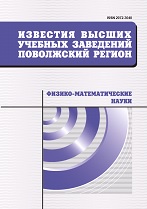|
Physics
A theoretical study of the electronic structure of gold nanotubes (8,0) within the Hubbard model
G. I. Mironov, A. D. Semenov
Mari State University, Yoshkar-Ola
Abstract:
Background. A theoretical study was conducted of the energy spectrum of gold nanotubes (8.0) within the framework of the Hubbard model in a node representation, the derivation of the equation for the chemical potential, correlation functions characterizing the electron hopping from the nanosystem node to the next node, the probability of finding two on one node d electrons with oppositely oriented projections of the spin and the ground state energy. A comparative analysis of the characteristics of gold nanotubes containing different numbers of gold atoms has been carried out. The anticommutator Green functions are given, the energy spectra and the density of electronic states are constructed. Materials and methods. To describe the properties of gold nanotubes, we built a model in which we believe that the main contribution to the physicochemical properties of gold nanotubes is made by d-electrons, since the energy levels of the s-electrons of gold are lower than the energy levels of d-electrons; The main physicochemical properties of nanotubes made of gold atoms are determined by d-electrons. The electron system of d-electrons is a system with strong correlations; therefore, in addition to transferring electrons from one node to a neighboring node, we take into account the repulsion energy of two d-electrons with different spin projections, which are found due to electron hops on one nanotube node. Therefore, we represent the real gold atom in the form of a d-electron moving around a positively charged ion made up of the nucleus and the rest of the electrons of the gold atom. Such a model is described by the well-known Hubbard Hamiltonian. Results. The anticommutator Green function was determined, the energy spectrum of gold nanotubes of chirality (8.0) containing different numbers of atoms was constructed and analyzed, the graphic form of the equation for the chemical potential was determined, the correlation functions were calculated, the ground state energy and the density of electronic states are given. Conclusions. An analysis of the study of the change in the electronic structure of a gold nanotube showed that with an increase in the number of atoms, the width of the lower (analogous valence band) and upper (analogous conduction band) Hubbard subbands increases. The width of the band gap between Hubbard pollens decreases with the growth of a nanotube, which suggests that nanotubes behave like semiconductors, with the number of gold atoms in a nanotube 128, asemiconductor-metal transition occurs. An increase in the number of atoms in a nanotube leads to a smoothing of the graph of the dependence of the ground-state energy on the ratio of the Coulomb potential to the hopping integral. This is due to the fact that as the nanotube size increases, the electrons of the peripheral atoms begin to less and less influence the electrons in the center of the structure under consideration. Also, with an increase in the number of atoms in a nanotube, the densities of electronic states are smoothed. The peaks of the density of electronic states correspond to the Van Hove singularities.
Keywords:
gold nanotube, Hubbard Hamiltonian, Green functions, Fourier transform of the anticommutator Green function, energy spectrum, chemical potential, ground state energy, ionization energy, electron affinity energy, density of electronic states.
Citation:
G. I. Mironov, A. D. Semenov, “A theoretical study of the electronic structure of gold nanotubes (8,0) within the Hubbard model”, University proceedings. Volga region. Physical and mathematical sciences, 2019, no. 2, 44–59
Linking options:
https://www.mathnet.ru/eng/ivpnz119 https://www.mathnet.ru/eng/ivpnz/y2019/i2/p44
|

| Statistics & downloads: |
| Abstract page: | 44 | | Full-text PDF : | 24 | | References: | 14 |
|




 Contact us:
Contact us: Terms of Use
Terms of Use
 Registration to the website
Registration to the website Logotypes
Logotypes








 Citation in format
Citation in format 